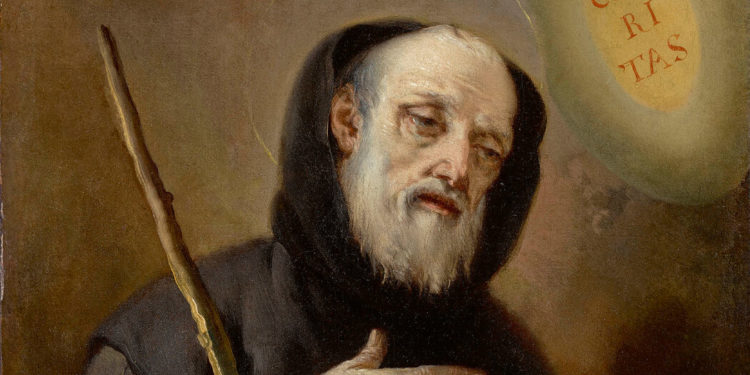News:
Sotheby’s Provenance Disputed in Claim by Heirs for Art Lost in Nazi Era
By Colin Moynihan
The relatives of a Jewish gallery owner who left a Tiepolo painting behind when he fled Austria say the auction house posted a misleading history of the work during a 2019 sale.

“St. Francis of Paola Holding a Rosary, Book, and Staff,” by Giovanni Battista Tiepolo, thought to have been painted in the 1730s
In 2019, Sotheby’s sold a work by Giovanni Battista Tiepolo, the master painter, that was left behind in Austria when a Jewish gallery owner fled the Nazis in 1938. Sotheby’s says that at the time of the sale it didn’t know that history, and so the auction catalog only mentioned that the work came from a “distinguished private collection” and had once been in the possession of the Galerie Wolfgang Böhler in Bensheim, Germany.
But, according to court papers filed Friday, the painting had actually passed through the hands of Julius Böhler, a separate and unrelated art dealer in Munich whom American authorities described in 1946 as someone who had been “implicated in art looting activities.”
Now three heirs of the Jewish gallery owner, Otto Fröhlich, are saying in the court papers that Sotheby’s “misled the public” by attributing the painting to the wrong gallery. This had the effect, the heirs said, of making a sale easier and “perpetuating the very cycle of injustice and exploitation that began in 1938 and that the international and national restitution laws and policies were designed to prevent.”
Sotheby’s, in response, attributed the provenance attribution in the 2019 catalog to “human error. “ The auction house said in a statement that it conducted new research after first hearing from the heirs and learned of an owner before Fröhlich who had been subject to Nazi persecution and whose heirs may have grounds for a claim.
“While Sotheby’s remains committed to reaching a just and amicable solution in the restitution of this work to its rightful heirs, additional research and evidence is needed to ascertain who the correct claimant should be in this instance, with current evidence supporting a possible claim by the heirs of Adele Fischel.”
Fröhlich bought the Tiepolo in 1938 from Fischel, who is described as his cousin in the court papers. Records maintained by the United States Holocaust Memorial Museum show that a woman from Vienna with that name was deported from Austria and later killed at the Theresienstadt camp. A representative for the Froelich heirs said Fischel’s sale to her cousin had been a “good faith,” mutually beneficial transaction between family members.
In the petition filed in State Supreme Court in Manhattan, the Fröhlich heirs did not say the Tiepolo had been looted, but they argue that the gallery owner would not have been forced to leave it behind but for the fact of Nazi persecution. Their petition asked the court to order Sotheby’s to disclose the identity of the seller and purchaser of the painting so they can begin a restitution claim.
The painting, “St. Francis of Paola Holding a Rosary, Book, and Staff,” by Tiepolo, was turned over to another gallery when Fröhlich fled Vienna for Britain, according to his heirs. It depicts the saint as a cowled, bearded figure, and the 2019 Sotheby’s catalog estimated its price as $70,000 to $100,000.
The Sotheby’s listing also cited a catalog raisonné of Tiepolo’s works published in 1962 that, the heirs’ petition says, correctly identified Julius Böhler in Munich as the person who once handled the painting, not Wolfgang Böhler who was listed in the Sotheby’s provenance.
In a telephone interview, Wolfgang Böhler’s son, Florian, said his father never sold or possessed the Tiepolo painting and that his father’s gallery was unrelated to other art businesses with the name Böhler, including the one in Munich.
Julius Böhler’s name appears several times in a 1946 report by the Art Looting Investigation Unit, a group created by the U. S government to look into World War II-era plundering and confiscation of art in Europe. In addition to listing Julius Böhler as someone implicated in art looting, it referred to him as “a strong Nazi.”
Fröhlich moved to London in 1938, the same year that Nazis required Jews in Germany and Austria to register property and assets. Near the end of 1938, the court papers say, Fröhlich transferred the Tiepolo painting for safekeeping to the Galerie Sanct Lucas in Vienna.
Documents compiled by the Mondex Corporation, which is working with the Fröhlich heirs to pursue a restitution, seek to track the painting’s history. One shows that Robert Herzig, the owner of the Galerie Sanct Lucas, obtained official permission in 1941 to sell the Tiepolo and other works to cover private debt he said Fröhlich owed his business.
But the petition asserts that the painting was sold far below the market and that, even if there had been outstanding debts, the Tiepolo only changed ownership as part of a “forced sale.” Absent Nazi persecution, Fröhlich’s heirs contend, he would not have been forced to close his gallery or leave Austria and could have repaid any debts without necessarily selling the Tiepolo painting.
Documents compiled by the Fröhlich heirs do not contain any more details about Julius Böhler’s role in handling the Tiepolo. But they show that Fröhlich tried after the war to get back some artworks, including that painting.
The Fröhlich heirs said they only became aware of the Tiepolo’s whereabouts after it was sold in 2019, according to their petition that seeks the identities of the parties involved in that sale. Auction houses typically do not reveal the names of consignors or buyers, but the heirs contend there is a basis to compel Sotheby’s to do so because that information is vital to future legal efforts to recover the painting.


